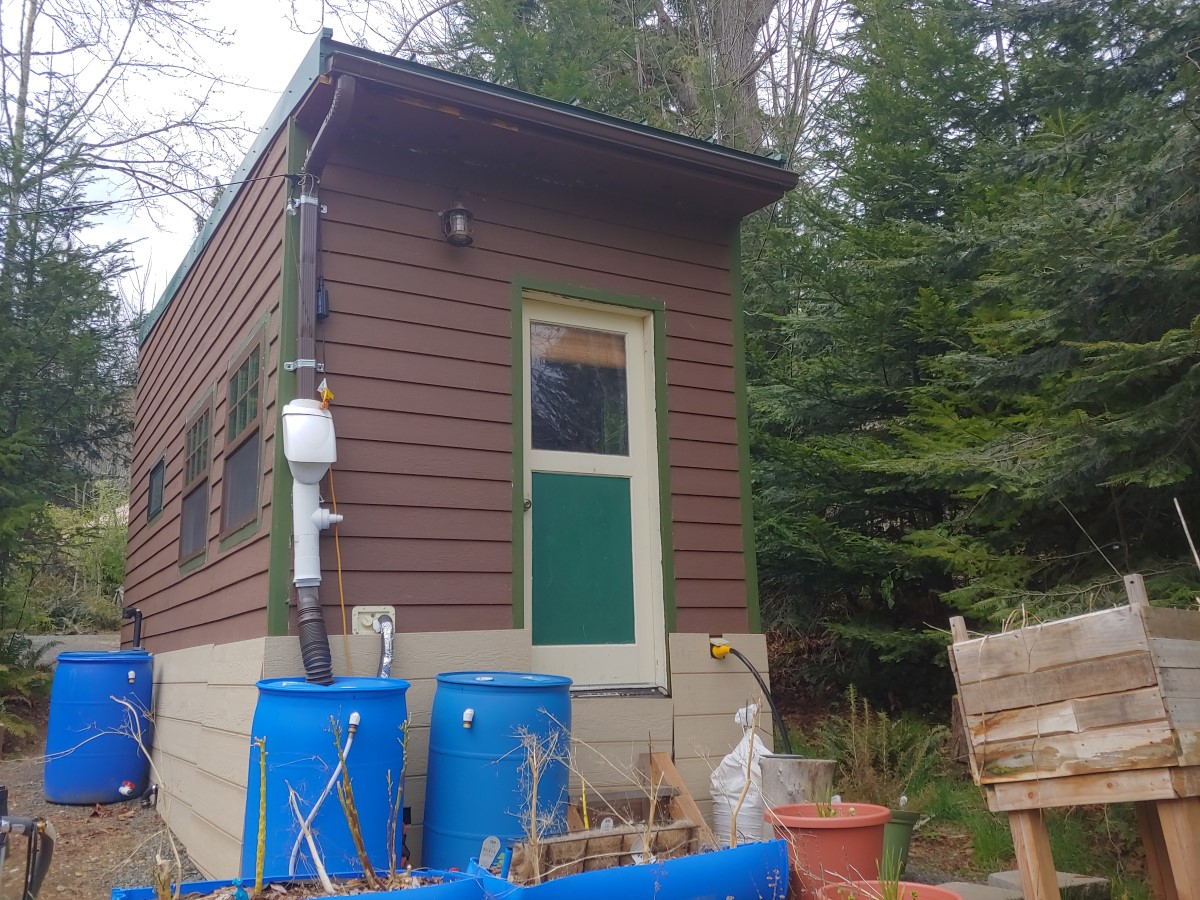Looks like you’ve been sucked down the minimal/mobile living rabbit hole. All of these floor plans look adorable and you can take your home wherever, whenever you wish! This is the dream, right!?
If this hippy is living the tiny house “dream” with the house he built “himself,” it must be pretty easy and for everyone!
Hang on. Let’s bring reality into the picture and see if this lifestyle really is for you.
Plus, I’ll give you some additional resources at the end so you can get started on this journey the right way.
Consideration 1 – What Does the Space Feel Like?
The very first thing you need to do after you’ve decided this is a route you want to go down is stay in a tiny house for at least a week.
Yes a week, not a weekend. Living this way isn’t going to be a vacation away from the real world. This is going to be your future life where you’ll be in this space full-time. Better to get a feel for a multi-day stretch in this space instead of just a weekend.
You can find several AirBnB hosts that provide tiny houses to stay in all over the world. This article has 50 different finds all over the globe to check out. This one has listings in the states. While this one has more listings that are on wheels (including a bus).
Stay in more than just one. A good way to pick which one to stay in is to find one that has a similar floorplan to what you would want to live in. Want a loft? Try one with ladder access and one with stair access to see what you’re comfortable with. Want to be on wheels? Stay in one that’s on wheels, then stay in one that’s on a foundation to feel the difference in space and what you have to compromise for mobility.
This is the way to really test the waters and find out if you can actually live this way. There are many stories of people moving into tiny houses and then moving back into a normal sized house within a year or less. The space change comes with a mental change. Less space means rethinking how you conduct your life and what you prioritize within it. If you don’t feel what it’s like to have a shift in priorities with a smaller living space, then you won’t last long in your tiny house.
For my journey, I visited a few tiny houses on wheels and then jumped into the build process. I was already living small and kept minimal things or things I could easily part with. My mentality was already thinking in terms of small spaces and what I wanted to prioritize having.
When I finally started building I moved closer to my build site and ended up living in the back half of a house that had very similar dimensions to the house I was building. It even had a loft for sleeping that needed a ladder to access. I built stairs in my house because ladders are terrifying.
If you don’t expect to change how you operate mentally in a smaller space, then you’re never going to like living in a small space.
Consideration 2 – To Be Mobile or Grounded
Both of these are going to have their own massive hurdles you have to figure out before you fully commit to one or the other.
First, if you’re planning on being on wheels and your trailer is 30 feet or over, I strongly suggest just building on a foundation. Moving something longer than 30 feet is going to require a professional or you having a trucking license. You won’t be able to account for all of the small roads and turns that it may take to find the parking spot for your house unless you pre-drive the route and really closely scout it out.
Also, many people that build this large of a size only ever move their house once. Then it’s a permanent fixture at whatever location it lands at.
So what was the point of putting it on wheels?
Now we get into the troubles with foundation builds. First, you need land. Most of us don’t have that. Finding a parking spot on someone else’s land seems a lot more feasible than trying to find an empty acre or two that you can afford in addition to the house build costs.
Then comes all of the local building regulations. Did you know that a majority of counties in the United States have a minimum square footage of 400 square feet in order for a structure to qualify as livable? This means if you want to build smaller than 400 square feet, you legally can’t live in that structure. Now that is being challenged more and more and not every county in the states is like that. However, you have to really do your research into local building codes to see what you can actually build in your area.
This was actually the original reason tiny houses on wheels popped up back in the day. Build a house on a trailer and it falls outside of local building codes because it’s not attached to the ground. This has obviously changed. Tiny house owners want their home to be legally defined so they can legally live in it all year round.
So now there are some codes around certain forms of tiny houses in certain areas of the country. That’s a pretty broad statement huh?
There are general building codes for tiny houses that are in the International Residential Code. However those only apply to tiny houses on foundations and only applies within states and counties that actually adopt that appendix. Then you get Washington state (Check out Final Bill Report under the Available Documents section) that has more details for tiny houses on wheels and how they regulate that build, but this isn’t the case for every state in the United Sates. Soooooooo you really have to look into your own local regulations and what is allowed.
Final note on if you want to build mobile, go through NOAH. This group uses standard building codes to help guide you in making sure your tiny house is built legally and safely. This certification can be enough for many local building inspectors if your house is challenged in its livability and safety, but again, is not always the case depending on where you’re located.
Consideration 3 – How to Get it Built
Alright, so you’ve got a floorplan you feel comfortable with, you’ve decided on if you’ll be on wheels or a foundation and know what’s needed to be legal, so lets go build this thing!
I’ll say that I did DIY when it came to my house. Would I suggest doing the DIY route? HELL NO. First, there’s no way you’re doing this yourself, you need someone else that has expert knowledge in plumbing, electrical and structural framing. So at the very least 3 hired professionals are helping you build this thing.
At that point finding a contractor that is willing to and has built tiny houses before is the best option so you know it is done right the first time and won’t take 3 years to build (that’s how long it took me to build my house with myself, a hired electrician and plumber while I worked a full-time job at the same time to pay for everyone and everything).
Once you find a trusted contractor (Here are three lists to help you decide what and who to look for: Best by Category, Listing by State and Best Known by State), setup inspections via NOAH or the local building regulator so that you, and everyone else that comes in contact with your house, knows that it was built safely. This only applies if you are buying blueprints and having your house built at a location closer to where you live or on a foundation, so the contractor is building someplace that isn’t their own warehouse. This is the closest to DIY you can get and do everything legally and safely.
Those three articles with lists of tiny house contractors include companies that have their own warehouse to build tiny houses in, which are either staffed or visited regularly by building inspectors. So if you’re okay with never hammering a nail into the frame of your house, then you can just hire one of these companies to take on the full build process and even ship the house to where you want it. It’ll cost a pretty penny but it’s one of the more worry free routes to go.
A note on van or bus builds, these will be falling into RVIA (RV build regulations) territory no matter what you do with it. If you want to live in a bus or van you can only legally do it temporarily (6-8 months), or else you’re boondocking and changing locations frequently. If you’re okay with that, (and that’s half the point of living in a bus or van, to move around a lot) then you can do a lot of that build DIY. I still recommend getting an electrician and plumber to help you retrofit those vehicles to be able to live in though.
Last Words and Consulting!
This should help you wrap your head around the logistics and options that you have if you want to live in some form of a tiny house.
For more specific help, my friend, Hannah Rose Crabtree, over at Pocket Mansions offers classes and consulting on tiny house design if you want to get direct answers to your exact questions on going tiny (side note, she helped lead the charge to get the legal definition of a tiny house on wheels in Washington State). They also have a tiny house for rent if you want to test the waters of living tiny!
There is also Ethan Waldman of thetinyhouse.net who does weekly podcasts with tons of amazing people that’ll help you get some bearings on where to go with all of this. Highly recommend his podcast about hiring contractors if you’re planning to hire someone to build anything. He also has a whole book he wrote called Tiny House Decisions that’ll help you on your way to figuring out your own path to living in a tiny house.
Finally, there’s the forum section of Panicked Hippy! That’s right, we have a whole discussion board on tiny/alternative living styles where you can chat with other hippies and get their experiences and suggestions on this tiny lifestyle.
For now, this should give you enough homework to figure out if you actually want to live this way and what plans you have to change that you initially had getting into this world.
Don’t worry, there’s always a living situation that will suit you best and if this doesn’t look like it’s in the cards for you right now, that’s totally cool! Home is where you make it! You can change little things in your situation that can lead to the better outcome you want, whether that’s living in a tiny house or not. Just thinking more on, how you’re living situation is affecting the world around you, is an amazing start to finding the right solutions for your lifestyle.
So remember, don’t panic, be a hippy.








Leave A Comment
You must be logged in to post a comment.